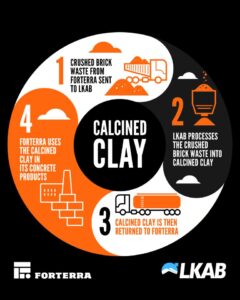Forterra makes substantial contribution to UK’s circular economy through innovative repurposing of brick waste

Forterra, has recently established an exciting partnership that reduces carbon emissions while making a substantial contribution to the UK’s circular economy through the innovative reuse of its manufacturing waste.
Taking a major step forward in its sustainability journey, Forterra has partnered with LKAB Minerals, part of the international mining and minerals group LKAB, to pioneer the repurposing of crushed brick waste to produce calcined clay as a low-carbon alternative to traditional cement.
Derived from recycled brick waste, calcined clay can be used as a cement replacement, known as a Supplementary Cementitious Material (SCM) in accordance with the cement standards. It brings a number of advantages, the most important of which is that SCM contributes to the concrete’s strength by increasing the strength producing compounds and in doing so reducing the porosity of the concrete.
Conventionally, calcined clay is produced by calcining raw clay at temperatures of between 700-800°C, but what is novel about Forterra’s approach is that this stage is avoided because the waste bricks had already been fired and the carbon accounted for in that process. This means that combustion emissions from the heating stage of the process are avoided, significantly reducing the embodied carbon of the final product.
To produce the calcined clay product, brick waste from Forterra’s Kings Dyke factory is crushed and delivered to LKAB Minerals, who then fine-mill the waste to a specific agreed specification, processing it into a reactive calcined clay material. Initial use of the calcined clay at one of our aggregate block plants in 2024 has resulted in a significant emissions avoidance of approximately 2,000 tonnes of CO2.
Forterra and LKAB Minerals will collaborate to manufacture approximately 35,000 tonnes of calcined clay per year, applying the circular economy principles of reuse and repurpose to these waste materials, making a significant contribution towards the construction industry’s carbon challenge.
The calcined clay partnership is part of a broader strategy to meet Forterra’s environmental, social, and governance (ESG) targets, including a 32% reduction in carbon emissions by 2030. Other recent projects have included the use of solar energy, reductions in single-use plastics, and investments in low-carbon transportation.
